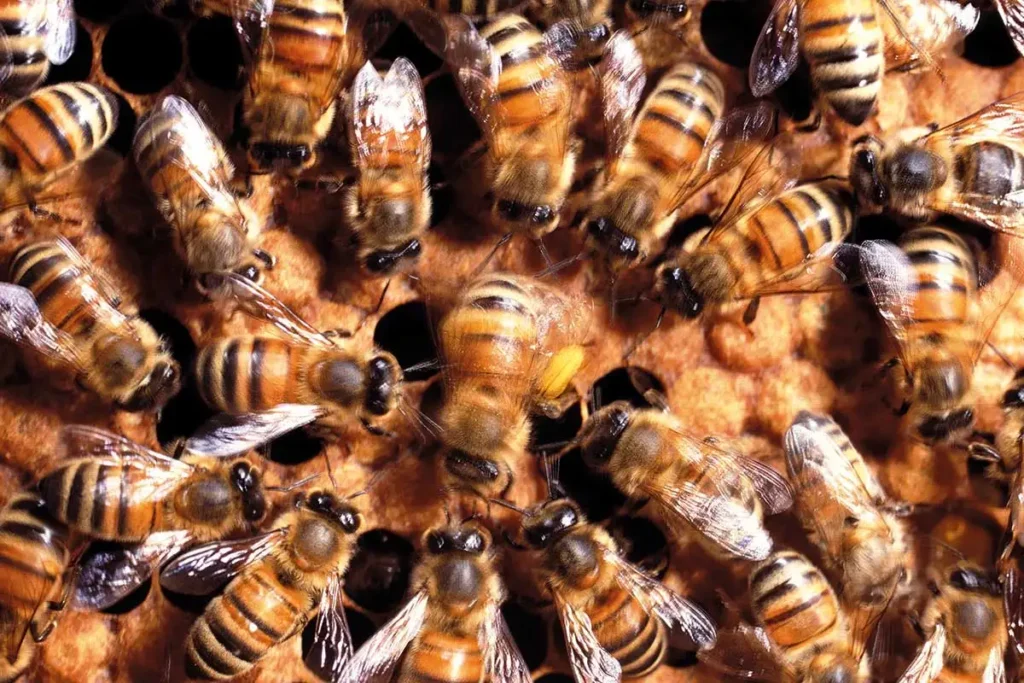Nature’s architectural marvels are often found in the most unexpected places. Among these, beehives stand out as extraordinary examples of intricate design and efficiency. Built by some of the smallest architects on Earth, beehives are not only a testament to the ingenuity of bees but also play a crucial role in our ecosystem. This article delves into the wonders of beehives, exploring their structure, significance, and the remarkable abilities of their tiny builders.
The Ingenious Design of Beehives
One cannot discuss beehives without marveling at their design. These structures are masterpieces of natural architecture, showcasing the brilliance of bees. Beehives are composed of hexagonal cells made from beeswax, each perfectly crafted to maximize space and efficiency. The hexagonal shape is not random; it allows for the most efficient use of space and materials, minimizing the amount of wax needed while providing maximum storage capacity.
Building Nature’s Architectural Marvel
Bees are truly nature’s architects. Worker bees, in particular, are responsible for the construction and maintenance of the hive. Using their bodies to measure and mold the wax, they create these hexagonal cells with remarkable precision. This process is a true reflection of Nature’s Architecture at its finest, where every element serves a purpose and contributes to the overall functionality of the hive.
Beehives in the Ecosystem
Beehives play a critical role in the environment. They serve as the home base for bees, which are essential pollinators for many plants. Without bees and their hives, many of the crops we rely on for food would struggle to reproduce. The efficiency and effectiveness of beehives as a base of operations for bees underscore their importance in maintaining ecological balance and supporting biodiversity.
Human Interaction with Beehives
While beehives are natural marvels, human interaction with them is often necessary. Sometimes, bees establish hives in locations that are not ideal for cohabitation with humans. In such cases, a professional bee removal service is essential. These services ensure that bees are safely relocated without harm, preserving their crucial role in the ecosystem while maintaining safety and comfort for humans.
The Architectural Significance of Beehives
From an architectural perspective, beehives stand out as extraordinary examples of design ingenuity. The hexagonal structure of the beehive cells is not just a random choice but a highly efficient form that has inspired various fields of human engineering and architecture. This hexagonal design maximizes space while using minimal materials, showcasing a perfect balance of form and function. The geometric efficiency of the hexagon allows bees to store the maximum amount of honey and pollen while using the least amount of wax. This principle of maximizing efficiency and strength is a core aspect of Nature’s Architectura, and it has influenced numerous human designs.
Architects and engineers have long admired the beehive’s structural efficiency. For instance, the concept of hexagonal tiling seen in various modern architectural designs and technologies mirrors the beehive’s layout. This design can be observed in products such as honeycomb structures used in aerospace engineering and building materials. These structures aim to replicate the beehive’s efficiency by providing strength and stability while minimizing material use. The beehive’s design also inspires energy-efficient systems and algorithms in technology, demonstrating how natural forms can influence innovative solutions.
The Lifecycle Within the Hive
Understanding the lifecycle within a beehive offers deeper insights into its architectural brilliance. A beehive is not just a shelter but a sophisticated system designed to support the entire life cycle of bees. The hive consists of various types of cells, each serving a distinct function. These cells are meticulously arranged to cater to the different needs of the colony, including storing honey, and pollen, and nurturing developing larvae.
The hive is divided into different sections to optimize its function. The worker bees create cells for honey storage, which is crucial for the colony’s survival during periods when nectar is not available. Pollen cells are used to store food that will feed the growing larvae. Meanwhile, the queen’s eggs are laid in brood cells, where the young bees develop until they are ready to emerge. This organized approach to space utilization ensures that every aspect of the hive’s operation is carried out efficiently.
Protecting Nature’s Architectural Marvels
Given their importance, it is crucial to protect and preserve beehives. Conservation efforts are essential to ensure that these natural structures continue to thrive. Supporting local beekeepers, planting bee-friendly plants, and avoiding harmful pesticides are some ways we can contribute to the preservation of these architectural marvels.
Summary
Beehives are truly Nature’s Architectural marvels, showcasing the incredible ingenuity and efficiency of bees. These structures are vital for the survival of bee colonies and the overall health of our ecosystem. As we continue to learn from and be inspired by Nature’s architecture, it is our responsibility to protect and preserve these wonders. Whether through supporting conservation efforts or utilizing professional bee removal service when necessary, we can ensure that beehives remain a thriving part of our natural world.






аккаунты с балансом заработок на аккаунтах
площадка для продажи аккаунтов купить аккаунт
магазин аккаунтов услуги по продаже аккаунтов
аккаунт для рекламы купить аккаунт
биржа аккаунтов аккаунты с балансом
гарантия при продаже аккаунтов https://ploshadka-prodazha-akkauntov.ru
магазин аккаунтов социальных сетей купить аккаунт
перепродажа аккаунтов безопасная сделка аккаунтов
профиль с подписчиками купить аккаунт с прокачкой
Website for Buying Accounts Account marketplace
Account Acquisition Find Accounts for Sale
Account Selling Platform Verified Accounts for Sale
Buy Account Purchase Ready-Made Accounts
Buy Pre-made Account Marketplace for Ready-Made Accounts
Account Buying Platform Sell Pre-made Account
Buy and Sell Accounts Account Catalog
Account Sale Account Market
Gaming account marketplace Find Accounts for Sale
Find Accounts for Sale Accounts market
Online Account Store Account Selling Platform
account trading platform https://cheapaccountsmarket.com
website for buying accounts online account store
account selling service website for selling accounts
marketplace for ready-made accounts https://accountsmarketbest.com
sell account account store
accounts market website for buying accounts
account market account market
find accounts for sale account exchange
account catalog account sale
account trading platform sell accounts
buy account sell accounts
social media account marketplace account exchange service
account exchange sell pre-made account
account store verified accounts for sale
account exchange service online account store
account catalog account trading platform
purchase ready-made accounts buy and sell accounts
social media account marketplace account trading platform
buy accounts account buying service
account trading service account trading
marketplace for ready-made accounts purchase ready-made accounts
account store buy account
accounts marketplace account trading
buy account account trading service
account market account selling platform
online account store sell accounts
buy and sell accounts account buying service
purchase ready-made accounts https://accounts-offer.org
account purchase https://accounts-marketplace.xyz/
profitable account sales https://buy-best-accounts.org
buy pre-made account https://social-accounts-marketplaces.live
account exchange service https://accounts-marketplace.live
account market https://social-accounts-marketplace.xyz/
secure account sales https://buy-accounts.space
account store https://buy-accounts-shop.pro/
find accounts for sale https://accounts-marketplace.art
account exchange https://social-accounts-marketplace.live
buy account https://buy-accounts.live
sell pre-made account https://accounts-marketplace.online/
account trading platform https://accounts-marketplace-best.pro
маркетплейс аккаунтов akkaunty-na-prodazhu.pro
купить аккаунт https://rynok-akkauntov.top/
маркетплейс аккаунтов соцсетей kupit-akkaunt.xyz
маркетплейс аккаунтов https://akkaunt-magazin.online
продажа аккаунтов https://akkaunty-market.live/
покупка аккаунтов https://kupit-akkaunty-market.xyz/
маркетплейс аккаунтов https://akkaunty-optom.live/
маркетплейс аккаунтов купить аккаунт
покупка аккаунтов akkaunty-dlya-prodazhi.pro
купить аккаунт https://kupit-akkaunt.online
cheap facebook advertising account https://buy-adsaccounts.work
buy aged facebook ads accounts https://buy-ad-accounts.click/
buy facebook accounts for advertising https://buy-ad-account.top
fb account for sale buy facebook ad account
buying facebook accounts https://ad-account-buy.top
buy aged facebook ads accounts facebook accounts to buy
buy facebook ad accounts https://ad-account-for-sale.top
buy fb ads account buy account facebook ads
buy fb ad account https://ad-accounts-for-sale.work
buy old google ads account google ads account buy
google ads account seller https://buy-ads-accounts.click
buy fb account https://buy-accounts.click
buy google adwords account buy aged google ads accounts
sell google ads account https://ads-account-buy.work
sell google ads account adwords account for sale
google ads accounts https://buy-account-ads.work/
adwords account for sale https://buy-ads-agency-account.top
old google ads account for sale https://sell-ads-account.click
buy facebook business manager https://buy-business-manager.org
buy google ads threshold accounts https://ads-agency-account-buy.click
google ads agency accounts https://buy-verified-ads-account.work/
buy verified bm facebook facebook business manager buy
buy facebook business manager accounts buy-bm-account.org
verified bm for sale https://buy-verified-business-manager-account.org
unlimited bm facebook verified business manager for sale
buy facebook business manager https://business-manager-for-sale.org/
buy business manager buy facebook verified business manager
buy facebook bm account buy facebook bm account
buy facebook bm account buy verified bm facebook
buy facebook ads accounts and business managers https://buy-business-manager-accounts.org
tiktok ads agency account https://buy-tiktok-ads-account.org
tiktok ads agency account https://tiktok-ads-account-buy.org
tiktok ad accounts https://tiktok-ads-account-for-sale.org
tiktok ads agency account https://tiktok-agency-account-for-sale.org
buy tiktok ad account https://buy-tiktok-ad-account.org
tiktok ad accounts https://buy-tiktok-ads-accounts.org
tiktok ads agency account https://buy-tiktok-business-account.org
buy tiktok ads account buy tiktok ads
buy tiktok business account https://tiktok-ads-agency-account.org
facebook ads account buy account exchange accounts marketplace